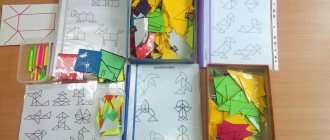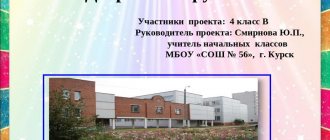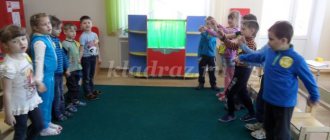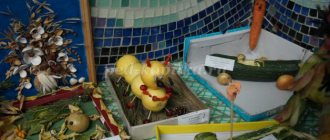Pedagogical project on the topic: “Mathematics is interesting”
- February 12, 2018
International and All-Russian competitions
All-Russian conference “Pedagogical project in a preschool educational institution”
Explanatory note for the project “Mathematics is interesting!”
Relevance of the project
Mathematics is a powerful factor in the intellectual development of a child, the formation of his cognitive and creative abilities. It is also known that the success of teaching mathematics in primary school mathematical .
Mathematics for children is most important in terms of memory development and further perception of mathematical information . For a more effective introduction of mathematics into the child’s mind , its study should, of course, begin in kindergarten. Moreover, you don’t have to be afraid of serious geometric shapes and other things. At this age, the child’s brain catches everything down to the smallest detail, and if sometimes the baby does not understand everything, it’s not scary, anyway, some part of the learning process is embedded in his memory, the brain begins to get used to new data. Gradually, after repetitions, the child will easily distinguish geometric shapes and learn to add and subtract.
It is very important in this regard to have the right approach, to work with the child only in a playful way, using the method of games and tips, otherwise strict classes will quickly become a boring time for the child, and he will not want to return to it anymore.
Why do many children find mathematics not only in elementary school, but even now, during the period of preparation for educational activities? Let's try to answer this question and show why generally accepted approaches to the mathematical preparation of a preschool child often do not bring the desired positive results. In modern training programs, important importance is attached to the logical component.
The development of a child’s logical thinking implies the formation of logical techniques of mental activity, as well as the ability to understand and trace the cause-and-effect relationships of phenomena and the ability to build simple conclusions based on cause-and-effect relationships. So that the child does not experience difficulties literally from the first lessons and does not have to learn from scratch, already now, in the preschool period, it is necessary to prepare the child accordingly.
Many parents believe that the main thing in preparing for school is to introduce the child to numbers and teach him to write, count, add and subtract (in fact, this usually results in an attempt to memorize the results of addition and subtraction within 10).
However, when teaching mathematics using textbooks of modern developmental systems, these skills do not help the child in mathematics . The stock of memorized knowledge ends very quickly after a month or two, and the child cannot independently perform the above mental actions on mathematical content , which leads to the appearance of “problems with mathematics .” The relevance of this issue prompted the idea to create the project “Mathematics is interesting!” on mastering children of middle preschool age - the ability to think logically, analyze, develop memory, attention and, most importantly, correctly express their thoughts out loud.
Project goals:
- To contribute to the creation of pedagogical conditions for the development of curiosity in older children, cognitive activity through entertaining developmental material .
- To increase the level of readiness of older preschool children for school.
- To develop the mathematical concepts of children 6-7 years old at an elementary level through the techniques of comparison, generalization, classification, systematization and semantic correlation.
- To promote the formation and development of the simplest logical structures of thinking and mathematical concepts in older preschoolers
Project objectives:
- develop interest in solving cognitive, creative problems, in a variety of intellectual activities;
- develop imaginative and logical thinking, the ability to perceive and display, compare, generalize, classify, modify, etc.;
- develop the ability to establish mathematical connections, patterns, order, the relationship of arithmetic operations, signs and symbols, relationships between parts of the whole, numbers, measurements, etc.;
- develop combinatorial abilities by combining color and shape, development of creative imagination, memory;
- to arouse the desire for a creative process of cognition and the implementation of strict actions according to the algorithm, self-expression in active, interesting, meaningful activities;
- promote the manifestation of children’s research activity in independent mathematical games, in the process of solving problems of various types, the desire to develop the game and search for results with unique, original actions (in their own way, at the level of age capabilities),
- developing interest in games that require mental stress and intellectual effort,
- promote the desire to achieve a positive result, perseverance and resourcefulness,
- formation of basic mathematical concepts and speech skills.
Expected Result:
- Children are active and independent in using mastered methods of cognition (comparing, counting, measuring, ordering) in order to solve practical, problematic problems and transfer them to new conditions.
- Children successfully solve logic problems.
- Show interest in experimentation. They are able to outline successive steps in the development of a situation, follow goals, and choose means.
- Actively involved in classification and series games; offer options; participate in transformation activities.
Methods used:
- Games
- Watching cartoons
- Conversations, quizzes
- Use of fiction
- Consultations for parents
- Creating a math corner in a group
- Demonstration of visual aids
- Presentations
- Application
- Drawing on semolina
Pedagogical project passport
| Structure | Content |
| Subject | “Mathematics is interesting!” |
| Project addressing | Children, teachers and parents of pupils |
| Project Manager | Grushina L.S. - preparatory group teacher Lazarenko N.S. - preparatory group teacher |
| Project participants | Teachers, children, parents |
| Age of pupils | 6-7 years |
| Project Features | By the nature of the product being created: Educational, playful, creative By number of participants: group; Duration: short-term (1 week); By level of contacts: at the level of the educational institution. |
| Objective of the project | — Contribute to the creation of pedagogical conditions for the development of curiosity in older children, cognitive activity through entertaining educational material. — To increase the level of readiness of older preschool children for school. — Develop the mathematical concepts of children 6-7 years old at an elementary level through the techniques of comparison, generalization, classification, systematization and semantic correlation. — To promote the formation and development of the simplest logical structures of thinking and mathematical concepts in older preschoolers. |
| Project objectives | — Develop interest in solving cognitive, creative problems, in a variety of intellectual activities; — Develop imaginative and logical thinking, the ability to perceive and display, compare, generalize, classify, modify, etc.; — Develop the ability to establish mathematical connections, patterns, order, the relationship of arithmetic operations, signs and symbols, relationships between parts of the whole, numbers, measurements, etc.; — Develop combinatorial abilities by combining color and shape, development of creative imagination, memory; — Arouse the desire for a creative process of cognition and the implementation of strict actions according to the algorithm, self-expression in active, interesting, meaningful activities; — To promote the manifestation of children’s research activity in independent mathematical games, in the process of solving problems of various types, the desire to develop the game and search for results through unique, original actions (in their own way, at the level of age capabilities). — Developing interest in games that require mental stress and intellectual effort. — Promote the desire to achieve a positive result, perseverance and resourcefulness. — Formation of basic mathematical concepts and speech skills. |
| Project Resources | Required support: — methodological materials. -fiction: “Three Bears”, “Two Little Bears”, “Twelve Months” by S. Marshak, “Flower - Seven Flowers” by V. Kataev; story by K. Ushinsky “Four Desires”. Memorizing poems about numbers, counting rhymes, riddles about geometric shapes and numbers. — electronic resources (Internet materials). |
| Intended project products | Expected positive results of the project: Products of the teacher’s activity: — Card index of mathematical riddles; graphic dictations by cells; labyrinths; “Entertaining mathematics” (proverbs, sayings, tongue twisters, poems, attention tasks, entertaining questions, logical endings, counting rhymes); Math problems in verse — Albums “Find the differences”, “Right-left, up-down. Orientation in space", "Games with counting sticks", "Didactic games in mathematics" — Summary of the conversation “How people learned to count” — Consultations for parents “Mathematics is interesting!” Memo for parents “Home mathematics: we are together” — Quiz “Guess it” — Didactic games: cut-out pictures “Days of the week and seasons”, “Number houses”, “Count it”, “Repeat the pattern”, “Mathematical scales” — Presentations “Mathematics in the preparatory group”, “Entertaining mathematics” — Creation of a math corner in the group Products of children's activities: -Applique -Drawing Products of parents' activities: — Watching cartoons at home with children “Back in the land of geometry”, “The story of the power of numbers”, “Learning to count from 1 to 20 with the hedgehog Zheka”, “Mathematical quantities” (educational cartoon) — Help from parents in creating didactic games for the group’s math corner. |
Stages of work on the project.
| Stages of work | The content of the work | Expected result |
| First stage: Preparatory Goal: to promote the development of interest in activities Second stage: Main Goal: to contribute to the accumulation of experience and necessary information Third stage Creative Goal: to promote the development, creativity, imagination, necessary practical skills in the artistic and creative activities of children | Introductory conversation with children "How people learned to count" Reading fiction: “Three Bears”, “Two Little Bears”, “Twelve Months” by S. Marshak, “Flower - Seven Flowers” by V. Kataev; story by K. Ushinsky “Four Desires”. Learning poems about numbers, counting rhymes, riddles about geometric shapes and numbers Didactic games: cut-out pictures “Days of the week and seasons”, “Number houses”. Watching cartoons “Island of Errors”, “Tamer of Numbers”. Math games. Guess Quiz Consultations for parents “Mathematics is interesting!” Memo for parents “Home mathematics: we are together.” Presentations “Mathematics in the preparatory group”, “Entertaining mathematics” Didactically games: “Count it”, “Repeat the pattern”, “Mathematical scales”, “Find the differences”, “Right-left, up-down. Orientation in space" Games with counting sticks Evening of entertaining mathematics Creating a math corner in a group Application “Animals from geometric shapes” Drawing geometric shapes on semolina | Summary of the conversation Book exhibition Didactic games: cut-out pictures “Days of the week and seasons”, “Number houses” Album “Didactic games in mathematics” Quiz summary Consultations for parents “Mathematics is interesting!” Memo for parents “Home mathematics: we are together” Presentations “Mathematics in the preparatory group”, “Entertaining mathematics” Didactically games: “Count it”, “Repeat the pattern”, “Mathematical scales” Albums “Find the differences”, “Right-left, up-down. Orientation in space" Album “Games with Counting Sticks” Card file “Entertaining mathematics” (proverbs, sayings, tongue twisters, poems, attention tasks, entertaining questions, logical endings, counting rhymes); "Math problems in verse" Creating a math corner in a group |
Project on FEMP in the senior group “In the Land of Geometric Shapes”
Project on FEMP in the senior group “In the Land of Geometric Shapes”
Geometry is full of adventures because behind every problem lies an adventure of thought. Solving a problem means experiencing an adventure.
V. Proizvolov
Relevance
Modern scientists note the great importance of geometry for the development of spatial thinking and imagination of a child, for his ability to see the world in holistic images.
Programs for the formation of initial mathematical concepts usually include introducing children to flat geometric shapes, and only a small part of the time is devoted to superficial acquaintance with three-dimensional geometric shapes.
This problem is of particular relevance in older preschool age in connection with the upcoming schooling.
Consequently, it becomes relevant to study and consolidate geometric bodies as one of the most important indicators of the development of spatial thinking and imagination of a child
Problem
: Analysis of the conversations and observations of children in free constructive activities revealed a problem - a superficial level of knowledge of volumetric geometric shapes.
Project participants:
children of the senior group, parents of pupils, teachers.
Project type:
informational and creative.
Date:
short-term (July).
Objective of the project:
1. To form children’s knowledge about geometric shapes and their distinctive properties;
2. Learn to analyze the shape of objects and individual parts, to find objects of the same and different shapes in the immediate environment;
3. Develop the ability to distinguish between models of figures that are similar in shape;
4. Develop an idea of how to make another from one form;
5.
Cultivate curiosity and interest in folklore.
Project objectives:
- To consolidate children's knowledge about geometric shapes (circle, square, rectangle, triangle) and geometric shapes (ball, square);
- Introduce children to the concepts of “quadrangle”, “oval”;
- Development in children of constructive abilities, the ability to transform one mathematical object into another, the development of analytical activity, the ability to classify;
- Develop interest in the application; develop storytelling skills using the do-it-yourself album “In the World of Geometric Shapes”;
- Develop communication skills.
Forms and methods of project implementation:
Thematic classes, presentations, b
Eseds, situations, memorizing poetry, board games, observations, role-playing, didactic games, looking at illustrations.
Project content:
— Organize creative activities for children: games, drawing, appliqué, etc.
— Together with the children, make an album “In the World of Geometric Shapes.” — Invite children to participate in a poetry competition about geometric shapes.
Expected results.
Children successfully:
- Master three-dimensional geometric shapes;
- They will learn to compare three-dimensional figures, highlight similarities and differences between them;
- They will learn to establish the relationship between flat and three-dimensional geometric shapes;
- Enrich the vocabulary with mathematical terms;
- They will learn to use the acquired knowledge in practical activities (when creating visual images, in constructive activities)
Parents:
They will be able to master the necessary techniques for working with children, which will allow them to solve issues of developing spatial thinking and imagination in children, for his ability to see the world in holistic images.
Project implementation:
| Stage | Action, event | Participants responsible | Deadlines |
| 1 stage: preparatory | Setting goals, determining the relevance and significance of the project | Educator | 1 Week |
| Selection of materials, study of methodological literature on this topic | Educator | ||
| Selection of visual and didactic material, fiction, illustrations | Educator | ||
| Organization of cognitive, developmental, subject environment | Educator | ||
| Consultation for parents Play didactic games with children: “Find geometric-shaped objects” (invite children to find geometric-shaped objects indoors). “What does it look like” (show the children geometric shapes and ask them to think, then name what they look like. For example: a circle, a saucer, a balloon, etc.) | Educator | ||
| 2 stage (basic, formative, practical) | Conversation with children “Geometric shapes around us”, “About pieces of furniture” | Educator | 2 week |
| Making didactic games on the topic | Educator Parents | ||
| Work on poems: Kozhevnikova A.Yu. “Learning the shapes of objects”, “Geometric shapes”, “Shapes of objects: Triangle, Square, Circle, Oval, Cone, Cube, Cylinder, Ball.” | Educator Children | ||
| Reading the Slovak folk tale “Visiting the Sun”, “The Tale of Geometric Figures”, conversation on their content. | Educator Children | ||
| Lesson summary “Playing with Cheburashka and the crocodile Gena.” | Educator Children | ||
| Creating a moving folder on the topic: “Introducing geometric shapes to older preschool children” | Educator | ||
| Creation of the book “Riddles and stories about geometric shapes” | Parents | ||
| Educational games “Find similarities and differences”, “Shape and quantity”, “Color and shape” (at the interactive table) | Teacher Children | ||
| 3 week | |||
| Outdoor game “This house has 6 floors” | Educator Children | ||
| Creative activity: Exhibition of children's drawings “Fairytale Country”, “Bus”. | Educator Children | ||
| Game “Close the windows” (using an interactive table) | Teacher Children | ||
| Exhibition of children's crafts made from colored paper. | Educator Children | ||
| Creation of the album “The World around Geometric Shapes”. | Educator Children | ||
| 4 week | |||
| Sand table activity “Draw a geometric figure from sand.” | Educator Children | ||
| Didactic game “Fold the figure.” (Using an interactive table) | Educator Children | ||
| Outdoor game “Make a figure”. | Educator Children | ||
| Lacing games | Educator Children | ||
| Game “Find the figurine’s house” | Educator Children | ||
| Construction of a bridge from cubes. | Educator Children | ||
| Creating a collection “Items of different shapes” (buttons, badges, etc.) | Teacher children | ||
| Didactic game “Collect beads” | Educator Children | ||
| Construction: “Let’s build a garage” | Educator Children | ||
| 3 stage: control and diagnostic, final | Diagnostics of acquired knowledge | Educator | 5 week |
| Exhibition of children's crafts made from colored paper. Exhibition of children's drawings “Fairytale Houses”, “Bus”. | Educator Parents Children | ||
| Poetry competition about geometric shapes. | Educator Children |
Conclusion
The project developed children's interest, desire to learn new things, curiosity, creativity, memory, and attention. Children learned to compare the shapes of objects with geometric patterns and find them in the environment.
Literature:
1. In the circle of friends of mathematics “Together things are going well” workbook by T.E. Erofeeva., 2013.
2. Games, quizzes, competitions N.V. Fedina manual for teachers., 2013.
3. Joint activities of adults and children: basic forms. O.V. Akulova, A.G. Gogoberidze, T.I. Grizik. N.V., 2012. Fedina.
4. Methodological recommendations. BUT. Berezina, O.E. Venetskaya, N.V. Fedina., 2011
5. Approximate basic educational program for preschool education. Project. S.N.Gamova, E.N. Gerasimova, N.V. Fedina., 2015.
6. Joint activities of adults and children main forms, O.V. Akulova, A.G. Gogoberidze, T.I. Grizik, N.V. Fedina., 2013.





